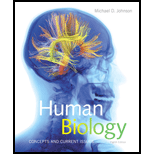
Why do you think that endocrine disruptors might cause more harm to children than to adults?
To review:
The rationale behind endocrine disruptions causing more harm to the children than adults.
Introduction:
Endocrine glands secrete chemical messengers (hormones) that are the mediators for various functions in the body. The hormones secreted by these glands help in wide functions like maintaining basal metabolic rate or BMR to the maturation of T-cells. There are certain chemicals found in the environment that can cause changes in endocrine functions, known as endocrine disruptors. These chemicals are especially bad for the health of the children.
Explanation of Solution
Endocrine disruptors can be defined as exogenous agents, which interfere with the production, release, transport, metabolism, binding, action, or elimination of the natural body hormones. Thus, the function of hormones to maintain the homeostasis and regulate the development process is hindered in the presence of endocrine disruptors.
Endocrine system plays an important role not just in biochemical processes, but it triggers and supports various events like childbirth, lactation, metabolic events, maturation, and puberty. In short, all the major bodily functions and life events are controlled by the endocrine system.
The endocrine disruption interferes with these functions. Thus, the body systems cannot perform their function properly. The endocrine hormones impose the harm in two basic ways that include the decreased or increased availability of the hormones.
These disruptions can cause more serious effects in children as compared to adults as children need different hormones for various events that can affect their entire life. Some of the major ones are as follows:
Bone length depends on the hormone calcitonin. Reduced level of calcitonin can result in stunted growth of the child.
Overall growth depends on the availability of growth hormone. When the growth hormone is underproduced, it can cause pituitary dwarfism while the extra availability of growth hormone causes gigantism. Both conditions affect different organs systems and psychological health of the child.
The thymus gland is active in children. The primary function of the thymus gland is the maturation of T cells. When this hormone is affected, the immunity of the child remains low throughout the life.
Thyroid hormones perform a variety of functions in the human body. Disruption of this gland can cause cretinism leading to mental retardation, growth retardation, and decreased BMR.
Most of the endocrine disruptions that happen in the later stages of life are manageable as the body is fully developed. Replacement of the hormones is enough for adults suffering from endocrine disruptions, but it is different in children.
The disturbed endocrine functions early in the growing period affect the children for the rest of their lives. Early diagnosis may help some of the children, but most of them develop irreversible changes due to endocrine disruption.
Therefore, it can be concluded that the endocrine disruption causes more harm in the children as the complications of these disruptions to affect the growth of the children and its implications are irreversible. The children affected by endocrine disruptions have to live with the certain deformities and reduced physical and mental functions for the rest of their lives.
Want to see more full solutions like this?
Chapter 13 Solutions
Human Biology: Concepts and Current Issues (8th Edition)
- Describe three cranial and postcranial features of Neanderthals skeletons that are likely adaptation to the cold climates of Upper Pleistocene Europe and explain how they are adaptations to a cold climate.arrow_forwardBiology Questionarrow_forward✓ Details Draw a protein that is embedded in a membrane (a transmembrane protein), label the lipid bilayer and the protein. Identify the areas of the lipid bilayer that are hydrophobic and hydrophilic. Draw a membrane with two transporters: a proton pump transporter that uses ATP to generate a proton gradient, and a second transporter that moves glucose by secondary active transport (cartoon-like is ok). It will be important to show protons moving in the correct direction, and that the transporter that is powered by secondary active transport is logically related to the proton pump.arrow_forward
- drawing chemical structure of ATP. please draw in and label whats asked. Thank you.arrow_forwardOutline the negative feedback loop that allows us to maintain a healthy water concentration in our blood. You may use diagram if you wisharrow_forwardGive examples of fat soluble and non-fat soluble hormonesarrow_forward
- Just click view full document and register so you can see the whole document. how do i access this. following from the previous question; https://www.bartleby.com/questions-and-answers/hi-hi-with-this-unit-assessment-psy4406-tp4-report-assessment-material-case-stydu-ms-alecia-moore.-o/5e09906a-5101-4297-a8f7-49449b0bb5a7. on Google this image comes up and i have signed/ payed for the service and unable to access the full document. are you able to copy and past to this response. please see the screenshot from google page. unfortunality its not allowing me attch the image can you please show me the mathmetic calculation/ workout for the reult sectionarrow_forwardIn tabular form, differentiate between reversible and irreversible cell injury.arrow_forwardhelparrow_forward
- Can you please help me answer these questions?arrow_forwardSkryf n kortkuns van die Egyptians pyramids vertel ñ story. Maximum 500 woordearrow_forward1.)What cross will result in half homozygous dominant offspring and half heterozygous offspring? 2.) What cross will result in all heterozygous offspring?arrow_forward
- Lifetime Physical Fitness & WellnessHealth & NutritionISBN:9781337677509Author:HOEGERPublisher:Cengage
 Comprehensive Medical Assisting: Administrative a...NursingISBN:9781305964792Author:Wilburta Q. Lindh, Carol D. Tamparo, Barbara M. Dahl, Julie Morris, Cindy CorreaPublisher:Cengage Learning
Comprehensive Medical Assisting: Administrative a...NursingISBN:9781305964792Author:Wilburta Q. Lindh, Carol D. Tamparo, Barbara M. Dahl, Julie Morris, Cindy CorreaPublisher:Cengage Learning  Human Heredity: Principles and Issues (MindTap Co...BiologyISBN:9781305251052Author:Michael CummingsPublisher:Cengage LearningEssentials of Pharmacology for Health ProfessionsNursingISBN:9781305441620Author:WOODROWPublisher:Cengage
Human Heredity: Principles and Issues (MindTap Co...BiologyISBN:9781305251052Author:Michael CummingsPublisher:Cengage LearningEssentials of Pharmacology for Health ProfessionsNursingISBN:9781305441620Author:WOODROWPublisher:Cengage





